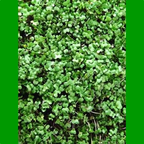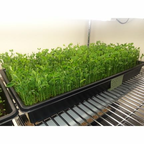Garden of Eden Urban Farming
Controlled environment agriculture, hydroponics, microgreens - Since 2013
Microgreens |
18 December 2025 |
Puget Sound Microgreens Project 2022-23
19 December 2022
Be part of the solution! Help your neighbors! Be a hero!
Is there a problem?
Yes! The Puget Sound region is regrettably home to several food deserts that leave our neighbors without access to healthy food. A "food desert" is any area in which poverty or lack of transportation prevent residents from obtaining good-quality food except at unaffordable prices or by long and expensive travel.What can be done?
Garden of Eden Indoor Farming, along with area food banks, other nonprofit groups and sponsors, has a plan for distributing up to 5,700 servings of nutritious microgreens weekly in cooperation with local food banks. Evergarden Farms is providing technical support to the project.What are microgreens?
Microgreens…- are young seedlings of edible vegetables and herbs typically harvested less than 14 days after germination when usually about 1-3 inches tall
- include popular varieties like cabbages, broccoli, kale, alfalfa, and others, plus mixtures in a rainbow of colors
- are popular with chefs as garnishes and flavor enhancers
- are recommended by nutritionists as "superfoods" that improve dietary variety and potency
- have been shown to contain many times the nutrition of the mature forms of the same species.
- More about microgreens
How can you help?
We have several automated growing systems, but right now they lack a home. We hope you might be willing to share some floorspace to host one or more systems and grow fresh vegetables to be distributed through local food banks.How will it work?
Microgreens from "your" garden will be combined with the produce of other locations and then packaged for distribution by food banks in Tacoma and Seattle. Our team will manage all aspects of growing and collection in 3-4 weekly visits to your premises.What is required?
The burden is small. Our team will provide all labor and administration. Each unit is similar in size to a typical vending machine. We need approximately 30 square feet (6x6) for each unit plus one 120v outlet on a 15a circuit and level access (no stairs). The monthly power consumption is small, and we will reimburse you based on KWH usage. Proximity to water is desirable, but the actual water usage is minimal due to the efficiency of the systems. Of course we also need access to the space, which can be at your convenience.How will my organization benefit?
In addition to supervising your garden, our team will also publicize your participation. At a minimum we will provide- a listing in our sponsor directory with your contact information and a statement about your business
- an "inline brochure" in the directory with more information and a graphic describing your company
- a link from our directory to your website
- optional access to edit and maintain your own listing content
- an extended description of your business and your participation in our Sponsors gallery—essentially a full page ad—with another link to your website
- a graphic on the project page with a link to the gallery presentation
- a graphic on our home page Partners list with a link to the gallery presentation, appearing randomly with no more than a dozen other partners' links whenever the home page is reloaded
What is the next step?
See the action plan on this page and contact us to begin.Equipment

Host one or more units similar to those shown.
Act today!
The procedure for setting up and operating your indoor garden are as follows. It's easy!
- Contact us!
- Meet with our team to choose a location and validate requirements*.
- Share a Memorandum of Understanding about the goals and procedures.
- You provide a key to the location OR arrange for someone to be present each time we inspect the crop.
- Our team delivers and installs the equipment (examples shown below).
- Our team starts the first crop with microgreens seeded elsewhere.
- Our team visits 3-4 times weekly to check progress.
- Our team visits once weekly to collect the crop for distribution.
- Our team starts the next crop with microgreens seeded elsewhere.
- Repeat sequence approximately weekly.
Not your cup of microgreens?
If this idea does not work for you, perhaps you'll tell a friend or neighbor who has the available space and capability. Kindly download our flyer.
|




